In a future Taiwan contingency, the United States and its allies and partners are poised to leverage large-scale autonomous unmanned aircraft system (UAS) operations to counter China’s anti-access/area denial strategy. This approach aims to mitigate the combined challenges of anti-access/area denial and the tyranny of distance that hinder US force projection in the Indo-Pacific. The United States Indo-Pacific Command Chief Admiral Samuel Paparo has highlighted the US military’s intent to transform the Taiwan Strait into an “unmanned hellscape,” creating an operational environment that severely disrupts Chinese invasion efforts.1 The hellscape concept aims to overwhelm Chinese systems with a massive deployment of autonomous unmanned aircraft vehicles (UAVs), which would perform multiple roles, including target acquisition, electronic countermeasures, and direct-attack missions. These UAVs would serve as a persistent threat, saturating Chinese air defenses, exhausting China’s missile stocks, and creating opportunities for US and allied forces to set the theater for large-scale combat operations. As Paparo indicated, these autonomous systems are not merely support assets: The systems represent a fundamental shift in how the United States plans to deter and—if necessary—defeat Chinese aggression in the Taiwan Strait.
To implement this vision, the US Department of Defense announced the Replicator Initiative in 2023, which aims to field thousands of “attritable autonomous systems” rapidly within a short timeframe.2 These artificial intelligence-enabled UASs are designed to be expendable, allowing them to be deployed in swarms that can overwhelm adversaries’ defenses. The procurement of systems like the Switchblade-600 loitering munitions and unmanned interceptor vessels reflects an urgent drive to bring this concept to fruition.3 This initiative is designed to augment existing US capabilities by providing a continuous flow of low-cost, attritable systems that can be deployed en masse to disrupt, deceive, and degrade adversary forces.
Similarly, the US Army’s Low Altitude Stalking and Strike Ordnance program further expands this approach, with plans to field semiautonomous loitering munitions that enhance the lethality of infantry brigade combat teams by maximizing standoff to mitigate the exposure of high-value assets to the People’s Republic of China’s countermeasures.4 Taiwan is also rapidly expanding its UAS capabilities, with the United States recently approving a significant sale of Switchblade 300 loitering munitions that would bolster Taipei’s ability to counter Chinese amphibious and naval operations.5 These developments underscore the rapidly evolving nature of UAS warfare, forcing China to innovate and adapt its strategies to maintain counterintervention advantages.
Nevertheless, the effectiveness of the hellscape concept hinges on maintaining technological superiority over Chinese anti-UAS capabilities. As the United States and Taiwan ramp up the acquisition and proliferation of unmanned systems, China is concurrently developing advanced counter-UAS technologies designed to resolve existing deficiencies and neutralize this threat. These technologies include sophisticated electronic warfare suites, anti-UAS laser weapon systems, and high-energy microwave weapons.6 The dynamic interplay between UAS proliferation and counter-UAS innovation will make the race to field these systems both a critical requirement and a significant vulnerability. Ultimately, the People’s Republic of China’s development and acquisition of counter-UAS technology poses a significant challenge for the implementation of the hellscape concept and, thus, undermines the success of future US and allied operations in the Taiwan Strait.
The People’s Liberation Army’s Current Capabilities and Perceived Weaknesses
The current counter-UAS capabilities of the People’s Liberation Army (PLA), shown in table 1, exhibit notable limitations that highlight the need for low-cost, high-performance, directed-energy weapons. Understanding currently fielded capabilities and their reported limitations enables better anticipation of the People’s Liberation Army’s future developments with subsequent implications for US Indo-Pacific strategy. The following matrix displays the People’s Liberation Army’s currently fielded counter-UAS equipment and the equipment’s identified deficiencies. Though each capability varies in performance, none are optimal for countering UAV swarms envisioned in the hellscape concept.
Table 1. The People’s Liberation Army’s counter-UAS capabilities
| Counter-UAS Capability |
Strengths |
Weaknesses |
Example of PLA System |
|
Conventional Air Defense: Surface-to-Air Missiles and Self-Propelled Antiaircraft Artillery
|
- Can target slow-moving UAVs effectively
- Proven effectiveness against certain UAV types
|
- High cost of missiles; not economical for low-cost UASs
- Rapid depletion of ammunition stocks against UAS swarms
- Air-defense radar has difficulty detecting small, slow, low-altitude UAVs
|
HQ-17 Surface -to-Air Missile
PGZ-95 Self-Propelled Antiaircraft Artillery
|
|
Jamming (Rifles/Vehicles)
|
- Versatile across all domains
- Effective against UASs reliant on external signals
|
- Limited by increasing UAS autonomy that reduces dependence on external signals
- Vulnerable to UAS swarms
- Line of sight, battery life, and range limitations for jamming rifles
|
JN1101 Vehicular Comprehensive Anti-UAV System
|
|
Armored Vehicle Smoke Screen
|
- Provides atmospheric obscuration, degrading UAV line of sight
- High mobility
|
- Smoke is finite and dissipates quickly, making it unsustainable against large-scale swarms
|
ZBD-05 Amphibious Assault Vehicle
|
|
Counterswarm UAVs
|
- Ground units outfitted with loitering munitions offer cross-domain capability for countering UAV swarms
|
- Limited supply of munitions
- Nascent tactical capability
|
CH-901
|
|
Aerial Net Interception System
|
- Nondestructive capture of UASs for intelligence exploitation
- Minimal risk to surroundings
|
- Low performance against high-speed targets; defeat one target at a time
- Performance relies on proper training; may struggle in dynamic situations
|
UAV-launched or Tube-Launched Net Interception System
|
Conventional Air Defenses
Most UAVs are susceptible to conventional countermeasures due to their slow speeds and lack of defensive systems. These countermeasures include antiaircraft guns, missiles, snipers, and man-portable systems to neutralize UASs. For instance, Ukraine has effectively employed World War II–era antiaircraft measures against UAVs.7 But advanced air-defense systems (figure 1 and figure 2) are not always economical for engaging low-cost systems.8 One RAND Corporation study notes Chinese air-defense batteries could quickly deplete their missile stocks when targeting UAS swarms.9 A recent instance demonstrates the People’s Liberation Army’s observation of antiaircraft artillery is a relatively ineffective means to counter UAV swarms. During one 2024 PLA Army air-defense training, the application of antiaircraft artillery proved only 40 percent effective in shooting down UASs.10 The high cost and low performance of air-defense artillery present a significant limitation in counter-UAS swarm capabilities.

Jamming Rifles and Vehicles
Jammers (figure 3) disable UASs by disrupting their connection to operators or creating interference that obscures control signals, making them versatile across all domains due to most UASs’ reliance on external signals. But increasing UAS autonomy reduces dependence on these signals, limiting the effectiveness of jamming. Additionally, emerging materials designed to absorb or reflect jamming are under development to protect sensitive UAS electronics, further diminishing the efficacy of jamming.11 Furthermore, jamming vehicles prove vulnerable to UAV swarms. Russia’s so-called mosquito repellant mobile jamming vehicle, employed during the Nagorno-Karabakh conflict, succumbed to UAS swarms and was ultimately destroyed.12 Jamming rifles provide a man-portable measure to counter UASs, though PLA analysts acknowledge these weapon systems are limited by line of sight, battery life, range, and the ability to engage multiple targets.13

Figure 3. JN1101 vehicular comprehensive anti-UAV system
(Source: News Center [
新闻中心], “
打造反无人机天罗地网,
中国电科推出“
天穹”
综合反无人机作战体系” [Building an Inescapable Net to Counter UAVs, CETCI Introduces the ‘Vault of Heaven,’ a Comprehensive System of Systems to Counter UAVs], CETCEI, n.d., accessed on October 28, 2024,
http://www.cetcei.com/zgdk/1593322/1593325/1751472/index.html. )
Armored Vehicle Smoke Screen
Armored vehicles are highly mobile and can therefore quickly maneuver to engage incoming UAVs. Smoke serves as an atmospheric obscurant that can effectively degrade UAVs’ line of sight (figure 4). But smoke shells are finite, and smoke screens dissipate quickly, rendering this approach unsustainable when facing large-scale UAV swarms.14 People’s Republic of China researchers from the Military Academy of Chemical Defense in Beijing highlight these limitations in their paper on the military applications of carbon aerogels (that is, solid smoke).15 A separate paper published from the Military Academy of Chemical Defense further explored the methods for evaluating smoke screens’ effectiveness against precision-guided weapons across different electro-optical bands, including visible light, infrared, laser, and millimeter-wave systems.16 The researchers point out the need for more advanced evaluation metrics to assess smoke screens’ performance under various battlefield conditions, acknowledging the limitations of current methods in reliably obstructing modern electro-optical guided munitions. The findings suggest further innovation is required in both smoke screen technology and alternative countermeasures to maintain battlefield superiority in such engagements.
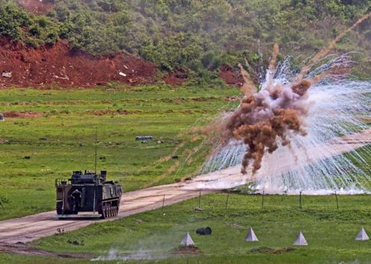
Figure 4. ZBD-05 amphibious assault vehicle firing smoke shells
(Source: Shu Ge [
数鸽], “
中国坦克上这一
装置可暂时“
隐形,
专门克制美国标枪导弹!” [Chinese Tanks Can Become Temporarily Invisible with this Device, Specially Countering the US’ Javelin Missile!], Sina, n.d., accessed on October 28, 2024,
https://k.sina.cn/article_6490713818_182e06eda001007onx.html)
Counterswarm UAVs: UAV Dogfights
According to the China Aerodynamics Research and Development Center, UAVs are the “natural enemy” of other UAVs.17 Therefore, employing UAVs with net launchers, and outfitting ground units with UAVs (such as loitering munitions) is an effective measure to hedge against UAV swarms. Research from the Naval Research Academy in Beijing highlights the development of both loitering munitions and reusable UAVs with onboard jamming systems or kinetic directed-energy weapons for hedging against UAV swarms.18 Taking inspiration from foreign systems like the United States’ Coyote and Russia’s Lancet, the People’s Liberation Army’s focus remains on developing cost-effective, intelligent systems that can counter UAV swarms autonomously.19 But PLA analysts note “UAV Dogfights” are a nascent countermeasure, and tactics, techniques, and procedures for using swarms to counter enemy swarms are currently under development.20
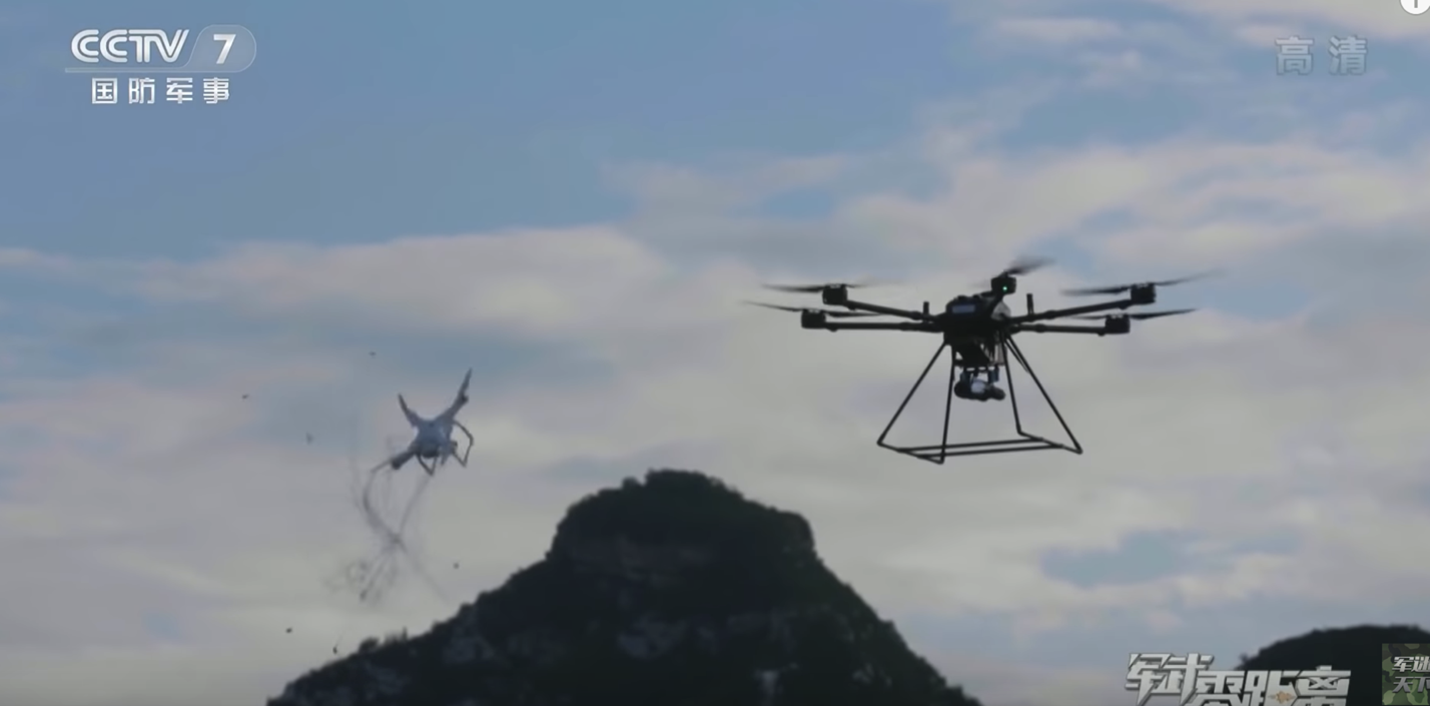
Figure 5. Aerial net interception system configured to a low, slow, small UAV
(Source: Junmi Tianxia, “
无人机上演‘
空中格斗’!
中国新概念安保装备大显神威!
看‘
天网一
号’
如何让‘
黑飞’
无所遁形,” Junmi Tianxia (June 2020), video,
Youtube link.)
Aerial Net Interception System
The People’s Liberation Army also deploys the aerial net interception system (figure 5) in counter-UAS operations, emphasizing the People’s Liberation Army’s high tolerance for targeting errors and minimal risk to the surrounding environment.21 Nets can be deployed from man-portable tube-launched systems (figure 6), ground vehicles, or airborne UAVs. This system offers a nondestructive solution by deploying a weighted net using air pressure through one barrel to entangle and neutralize targeted UASs. The net captures UASs without destroying them and ensures the UASs are brought down safely, making the net suitable for use in populated areas, over the heads of soldiers, or close to friendly units. The primary advantage of this system is its ability to preserve the integrity of the captured UAS for forensic analysis and intelligence exploitation. Though effective at close range, the aerial net interception system’s performance is contingent on individual skill. Furthermore, PLA analysts state the People’s Liberation Army’s inability to defeat multiple targets simultaneously and the limited range are significant drawbacks in a dynamic operational environment with targets moving at high speeds.22
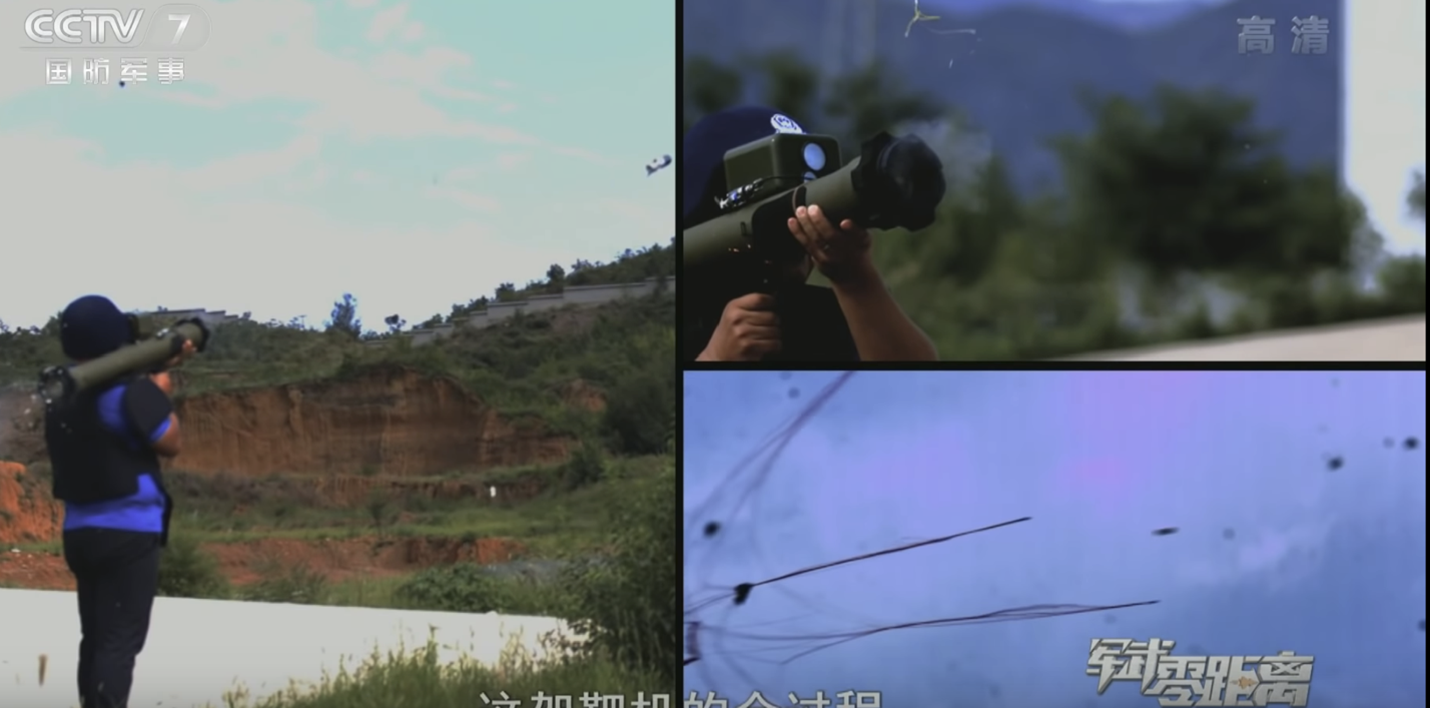
Figure 6. Aerial net interception system launched from man-portable shoulder-fired weapon
(Source: Junmi Tianxia, “
无人机上演‘
空中格斗’!
中国新概念安保装备大显神威!
看‘
天网一
号’
如何让‘
黑飞’
无所遁形,” Junmi Tianxia (June 2020), video,
Youtube link.)
The People’s Liberation Army’s Development of Laser Systems
The People’s Liberation Army has increasingly focused on developing laser weapons as a core counter-UAS technology, leveraging unique advantages to offset the limitations of conventional capabilities. Laser weapons are particularly effective in countering UAV swarms due to the weapons’ operational flexibility, cost-effectiveness, and rapid target-engagement capabilities.
Laser weapons work by converting electrical energy into a focused beam of photons, capable of either soft- or hard-kill effects. Soft kills involve damaging a UAS’s sensors, such as charge-coupled device sensors, infrared imaging, and other optical systems, rendering them ineffective. Ren Yan et al., from the Xi’an Institute of Electronic Engineering, demonstrate how laser weapons can damage UAS sensors through targeted energy bursts, causing UASs to lose target-acquisition capabilities and ultimately neutralizing their combat effectiveness.23 This method provides a decisive advantage, as the method directly disrupts the core functionality of the UAS without the need for traditional kinetic interceptors, which may be slower and more costly. On the other hand, hard kills involve burning through the UAS’s structural components (such as the UAS’s carbon fiber body), causing the UAS to crash. Researchers from the People’s Liberation Army’s Air Defense and Missile College, PLA Unit 63768 in Xi’an, and the Department of Basic Engineering at the Space Engineering University conclude this flexibility is a key advantage of laser weapons, allowing the system to be tuned to mission requirements, ranging from temporary blinding of sensors to outright destruction.24
Additionally, laser weapons offer a significantly lower cost per shot compared to traditional air-defense systems. People’s Republic of China analysts estimate the cost of firing a laser beam is one US dollar, whereas interdicting UASs with conventional missile systems could cost hundreds of thousands to millions of dollars per engagement.25 This disparity underscores the cost savings of deploying laser systems, especially when countering the large-scale UAV swarm operations the United States envisions in its hellscape program.
The same analysts also note the rapid target-engagement and fire-transition capabilities of laser weapons greatly enhance their utility in counter-UAS operations.26 Specifically, laser systems can switch between targets in less than a second, effectively responding to multiple threats in a condensed time frame. This swift adaptability allows laser-equipped units to maintain a high rate of fire and continuously suppress UAS formations while offsetting the challenge of magazine depth inherent in conventional, missile-based systems.
In 2022, researchers at the Xi’an Institute of Electrical Engineering tested tactical laser suppression against UAV swarms using a task organization of a mobile ground radar and three tactical, vehicle-mounted lasers. Based on the test, the researchers concluded the tactical application of the three vehicle-mounted lasers used in tandem with radar was decidedly effective against a swarm of six rotary-wing UAVs at range of 1.8 kilometers to three kilometers. Later that year, China Aerospace Science and Industry Corporation unveiled the LW-30 (30kW) and LW-60 (60 kW) laser defense weapon systems (figure 7)— “all-domain offensive/defensive weapons” designed to be highly mobile and deployed individually or networked together.27 Although how extensively these systems have been fielded in air-defense units across the People’s Liberation Army is unknown, they represent a building block for a low-altitude, integrated air-defense network designed for countering low, slow, small UAVs.
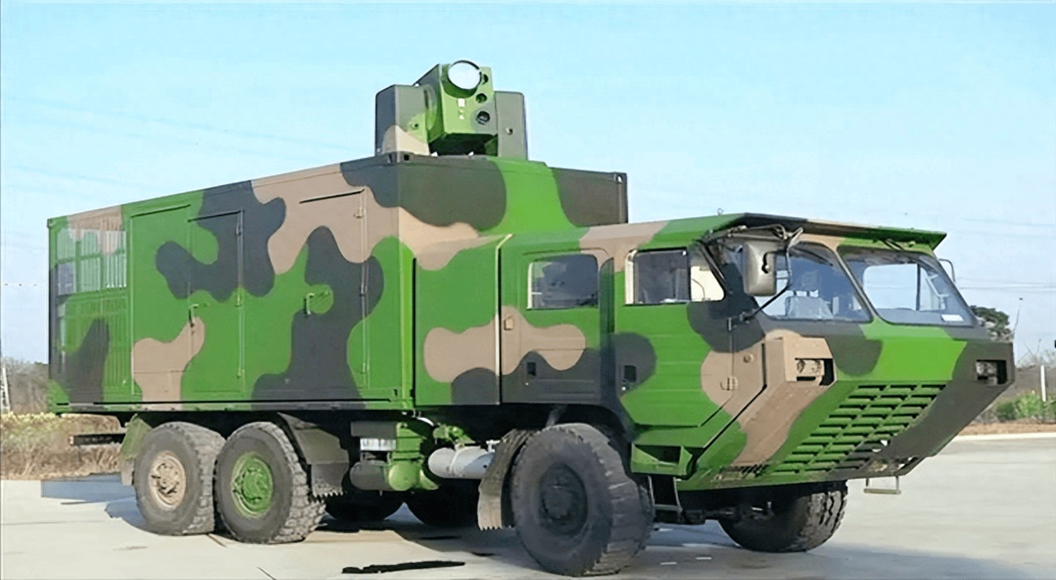
Looking ahead, PLA research will focus on laser power scaling and systems integration to counter US attempts to use low-cost, attritable UAVs to saturate and overwhelm traditional defense systems. In the near term, research on directed-energy systems will continue to focus on increasing the power of lasers. China is investing in technologies—including solid-state, chemical, fiber, and free-electron lasers—to achieve power levels exceeding 50 kilowatts that can eliminate hardened targets under high-intensity battlefield conditions.28 Li Zhenhua indicates 10 kilowatt lasers can damage UAS sensors and hulls at close range, 50 kilowatt lasers can destroy UASs outright, and 100 kilowatt lasers can neutralize rockets and mortar rounds.29
In addition, as noted by Liu Wei et al., future laser weapon systems are expected to evolve toward networked architectures.30 This development will include multilaser arrays working in coordination to form a dense field of laser fire, challenging saturation attacks from large UAS swarms. The People’s Liberation Army’s ambition to establish an integrated laser-based defense system is evident in existing research that focuses on connecting distributed tactical systems across all domains, including coordinating laser weapons with traditional air-defense assets, thereby creating a multilayered and adaptive defensive network.
During the People’s Republic of China’s 14th Zhuhai Airshow, the China Aerospace Science and Industry Corporation shed light on the multilayered defense network described above. This defense network, also called a “counter UAS system of systems” (反无人机体系), is composed of an early warning system, command-and-control system, and interception system, detailed below.31
Table 2. Counter-UAS SoS composition
| Early-Warning System (预警系统) |
|
|
DK-1 low-altitude detection radar
|
Electro-optical radar capable of positioning more than 20 targets in a mid-range from 500 meters to 18 kilometers per second.
It can also monitor and track mobile ground targets.
|
|
JCL100 gap-filling radar
|
A compliment to larger sensors.
Covers areas outside the line-of-sight of other sensors or in areas blocked by terrain or other structures.
|
|
Sensors of interception system
|
Radar, Electro-optical/Infrared
|
| C2 System (指控系统) |
|
|
ZK-K20 command-and-control system
|
Operates medium- and long-range air defense assets (including HK-17AE short-range missile system and new FK-3000 platform) to intercept large combat drones, as well as perform short-range countermeasures against medium, small or mini-drones, including drone swarms.
|
|
WarLinkz cloud
|
Networks disparate tactical systems together, enabling real-time data sharing and communication.
|
| Interception System (拦截系统) |
|
|
HQ-17AE combat vehicle
|
A low to medium altitude, short-range air defense system built on a 6x6 wheeled chassis.
Carries radars and a basic load of 16 missiles with an effective range of 1.5 to 20 kilometers.
|
|
HQ-17AE fire support vehicle
|
A manned or unmanned platform based on the HQ-17 wheeled chassis.
Carries 48 short-range and 24 very-short range missiles.
This system is also equipped with an EW suite.
|
|
FK-2000 combat vehicle
|
A self-propelled missile-gun air defense system with a range of 0.2 to 25 kilometers.
Employs active radar and electro-optical sensors.
Able to track and engage targets while on the move.
|
|
FK-3000 combat vehicle
|
A self-propelled anti-missile system with an effective range of 200 meters to 12 kilometers.
|
|
ZR-1500 unmanned ground vehicle
|
Designed to be deployed alongside the HQ-17.
Carries a basic load of 12 micro missiles and 4 small missiles with a range of 5 kilometers.
|
|
QW-12/19 MANPADS
|
Man-portable, shoulder-fired air defense weapons with a max effective range of 5,200 meters.
Employs active laser and dual-band infrared passive guidance systems.
|
|
LW-30 laser weapon
|
A mobile, networked, 30-kilowatt laser, capable of tracking and locking onto a low-altitude target in 6 seconds at a range of 25 kilometers.
|
|
Aerial net interception system
|
Ground-based launcher equipped with electro-optical sensors
|
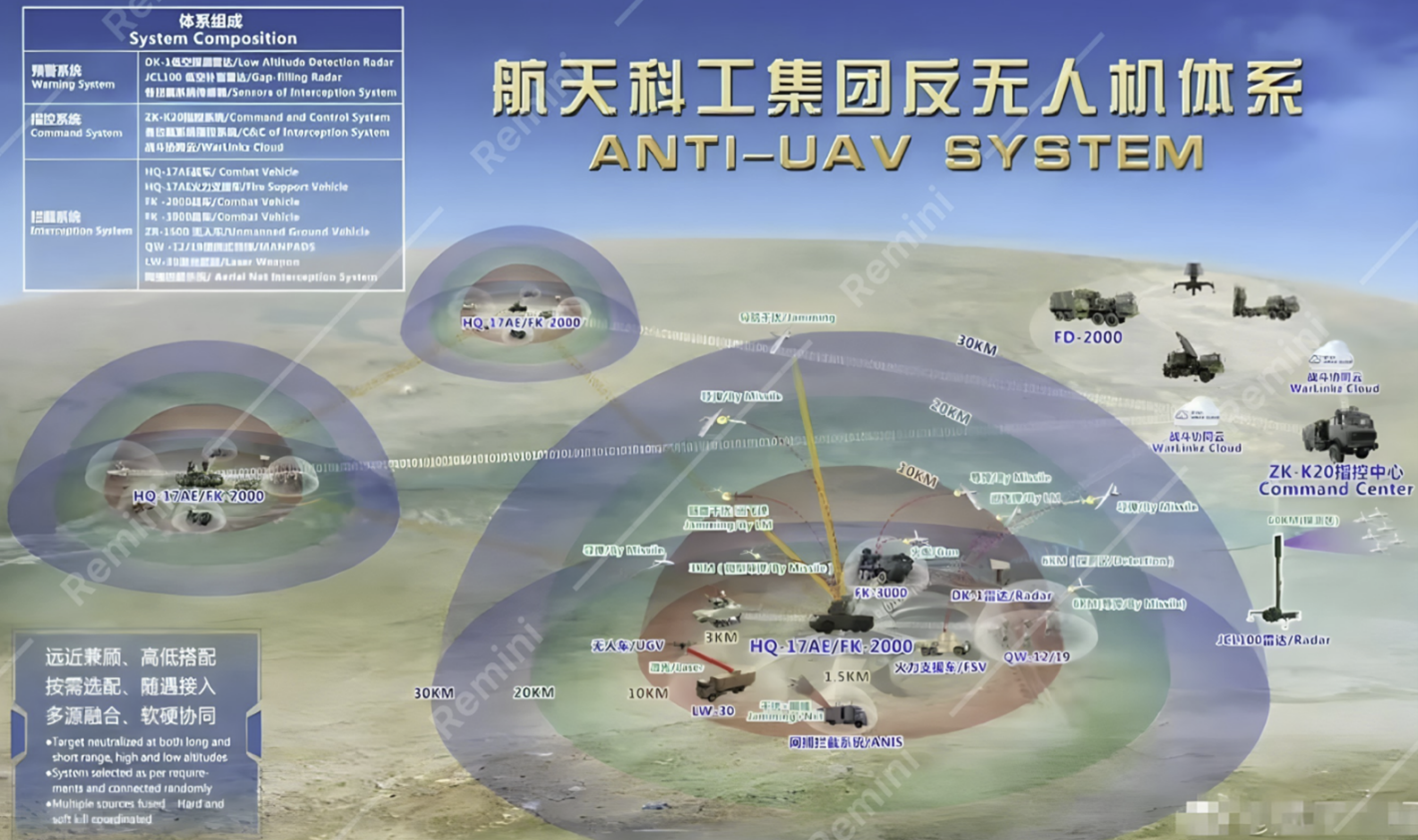
This counter-UAS system of systems (figure 8) integrates various sensors under a unified command-and-control architecture, superimposing various short-, medium-, and long-range air-defense capabilities. This approach allows for scalable and flexible coordination of both soft- and hard-kill measures to neutralize aerial threats effectively at both high and low altitudes.32 The successful development and integration of lasers with an output power of 50 kilowatts and 100 kilowatts will further augment the range, scalability, and kill factor of the counter-UAS system of systems, constituting a significant defense system against UAV swarms.
Conclusion
Although the People’s Liberation Army is likely prioritizing the research, development, and acquisition of directed-energy weapons to counter UAV swarms, such weapons have vulnerabilities that can be exploited. A laser must have a clear, straight path to its target without any obstructions. Therefore, lasers can be defeated or degraded by atmospheric obscurants or reflective surfaces.33 Furthermore, lasers are subject to the technical and logistical challenges of generating, storing, transmitting, and using large amounts of energy in austere operational environments.34
The People’s Liberation Army’s successful development and fielding of 50 kilowatt and 100 kilowatt directed-energy weapons within 5–10 years will challenge the success of the hellscape concept in the medium to long term. With the Pentagon poised to spend $1 billion on a fleet of replicator UAVs by fiscal year 2025, the cost and scale of the program will likely be strained by the People’s Liberation Army’s evolving integrated air-defense network, comprising interconnected and highly mobile lasers.
To defeat, deny, or degrade PLA lasers, the United States must prioritize hardening its UAVs against directed-energy capabilities. This prioritization includes addressing technological solutions that enable UAVs to lower their probability of detection and interception while maintaining their own ability to sense and act. Additionally, targeting PLA support vehicles and infrastructure (such as generators, power banks, and fueling trucks) will deny lasers the ability to replenish and effectively operate. Ultimately, in light of this emergent threat, the United States must leverage technological innovation and operational adaptability to exploit laser-system vulnerabilities and secure long-term strategic advantages.
Jake Rinaldi
Dr. Jake Rinaldi is a defense analyst in the China Landpower Studies Center within the Strategic Studies Institute at the US Army War College. He holds a PhD and MPhil from the University of Cambridge, where his doctoral dissertation examined China–North Korea military relations, and his master’s degree focused on China’s nuclear forces.
Jake Vartanian
Jake Vartanian is a military analyst at the US Army War College China Landpower Studies Center. His primary research topics include People’s Liberation Army (PLA) Army operational and tactical capabilities, PLA joint operations, and Chinese strategic landpower.
Endnotes
- Josh Rogin, “The US Military Plans a ‘Hellscape’ to Deter China from Attacking Taiwan,” The Washington Post, June 10, 2024, https://www.washingtonpost.com/opinions/2024/06/10/taiwan-china-hellscape-military-plan/. Return to text.
- “Deputy Secretary of Defense Kathleen Hicks Keynote Address: ‘The Urgency to Innovate’ (as Delivered),” U.S. Department of Defense, August 28, 2023, https://www.defense.gov/News/Speeches/Speech/Article/3507156/. Return to text.
- Courtney Albon, “Army to Buy More Than 1,000 Switchblade Drones Through Replicator,” C4ISRNET, June 21, 2024, https://www.c4isrnet.com/unmanned/2024/06/21/army-to-buy-more-than-1000-switchblade-drones-through-replicator/; and Justin Katz, “Replicator’s ‘PRIME’ Time: DIU Seeks Small USV Interceptors Ready for Rapid Production,” Breaking Defense, January 30, 2024, https://breakingdefense.com/2024/01/replicators-prime-time-diu-seeks-small-usv-interceptors-ready-for-rapid-production/. Return to text.
- Jon Harper, “Army Requesting More Than $120M for LASSO Kamikaze Drones in Fiscal 2025,” DefenseScoop, March 12, 2024, https://defensescoop.com/2024/03/12/army-lasso-drones-fiscal-2025/. Return to text.
- Simina Mistreanu, “US Approves New $360 Million Arms Sale to Taiwan for Drones, Related Equipment,” Associated Press, June 18, 2024, https://apnews.com/article/us-taiwan-china-arms-5eb7e3b35775e813c525a019228ee1a4; and Jim Morris, “Pentagon to Send Switchblade Attack Drones to Taiwan,” Warrior Maven, July 6, 2024, https://warriormaven.com/china/pentagon-to-send-switchblade-attack-drones-to-taiwan. Return to text.
- Ren Yan et al., “Research on Application of UAV Swarm and Laser Anti-UAV Technology” [无人机蜂群与激光反无技术应用研究], Fire Control Radar Technology 51, no. 3 (September 2022): 111–18, DOI: 10.19472/j.cnki.1008-8652.2022.03.022. Return to text.
- Zachary Kallenborn and Marcel Plichta, “Breaking the Shield: Countering Drone Defenses,” Joint Force Quarterly 113 (2nd Quarter 2024): 26–35. Return to text.
- “Serbia Continues to Purchase Chinese Equipment with Acquisition of HQ-17AE Air Defense Missile Systems,” Global Defense News Army Recognition Group, June 28, 2024, https://armyrecognition.com/news/army-news/army-news-2024/serbia-continues-to-purchase-chinese-equipment-with-acquisition-of-hq-17ae-air-defense-missile-systems. Return to text.
- Thomas Hamilton and David A. Ochmanek, Operating Low-Cost, Reusable Unmanned Aerial Vehicles in Contested Environments: Preliminary Evaluation of Operational Concepts (RAND Corporation, May 2020). Return to text.
- “China's PLA Found ‘Shooting at Drone Swarms Challenging’ in Recent Air Defence Drills,” Bangkok Post, September 2, 2024, https://www.bangkokpost.com/world/2858013/chinas-pla-found-shooting-at-UAS-swarms-challenging-in-recent-air-defence-drills. Return to text.
- Jacob Thompson, “Nonlinear Effects in Transformation Optics-Based Metamaterial Shields for Counter Directed Energy Weapon Defense” (master’s thesis, Naval Postgraduate School, 2016), 137, https://apps.dtic.mil/sti/pdfs/AD1026841.pdf. Return to text.
- “New Russian Anti-Drone Warfare System Was Destroyed by . . . a Drone,” BulgarianMilitary.com, October 1, 2020, https://bulgarianmilitary.com/2020/10/01/new-russian-anti-drone-warfare-system-was-destroyed-by-a-drone/. Return to text.
- Junmi Tianxia, “PLA Unveils a Large Number of ‘Black Technologies’! Drone Countermeasure Guns are ‘Night Flyers’ Nemesis, and the New Generation of Exoskeletons Can Easily Lift over 40kg of Armor-Piercing Ammo” [解放军公开大批‘黑科技’!无人机反制枪堪称‘黑飞’克星 新一代单兵外骨骼可轻松搬起40多公斤的穿甲弹!] Military Documentary, January 4, 2022, https://www.youtube.com/watch?v=nym_vGoPoOg; ANZE Technology (安则科技), “What Is a Drone Countermeasure Gun? Classification of Anti-Drone Methods and Their Advantages and Disadvantages” [反无人机枪是什么? 反无人机的手段分类及优点缺点], http://www.wurenjifanzhi.com/a/599.html; and “Understanding Anti-Drone Systems and How Anti-Drone Guns Work,” Drones and UAV News, August 23, 2024, https://droneinternationalexpo.com/blog/anti-drone-systems/. Return to text.
- Ren Yan et al., “UAV Swarm and Laser Anti-UAV Technology.” Return to text.
- Zhao-liang Yu et al., “Research Progress on the Military Applications of Carbon Aerogel” [碳气凝胶军事应用技术研究进展], Carbon 2020, no. 1 (182): 17–23, doi:10.39694/issn1001-8948.2020-01-003. Return to text.
- Jia-lin Ding et al., “Evaluation Indexes and Calculation Methods of Smoke Interference Effect” [烟幕干扰效果评估指标及计算方法], Infrared 45, no. 3 (2024): 29–39, doi:10.3969/j.issn.1672-8785.2024.03.005. Return to text.
- Hai Chen et al., “Challenge and Countermeasure of Land Mobile Force Anti-UAV Swarm Operation” (陆上机动力量反无人机集群作战的挑战与对策), Command Information System and Technology 15, no. 3 (June 2024): 61–65, doi:10.15908/j.cnki.cist.2024.03.009. Return to text.
- Mo Zhou et al., “Research on Foreign Anti-UAV Swarm Warfare” (国外反无人机蜂群作战研究), Command Control & Simulation 45, no. 2 (April 2023): 24–30, doi:10.3969/j.issn.1673-3819.2023.02.004. Return to text.
- Mo Zhou et al., “Research on Foreign Anti-UAV.” Return to text.
- Ren Yan et al., “UAV Swarm and Laser Anti-UAV Technology.” Return to text.
- Mi Yize, “The Scientific Principles Behind Using Airborne Net Guns to Counter Drones” [米轶泽, 利用机载网枪反无人机背后的科学原理], YouUAV.com, April 11, 2022, https://m.youuav.com/news/detail/202204/52640.html. Return to text.
- Junmi Tianxia, “无人机上演‘空中格斗’!中国新概念安保装备大显神威!看‘天网一号’如何让‘黑飞’无所遁形,” Junmi Tianxia (June 2020), video, . Return to text.
- Ren Yan et al., “UAV Swarm and Laser Anti-UAV Technology.” Return to text.
- Liu Wei et al., “Application and Key Technologies of Laser Weapons in Anti-UAV Swarm Operations” [“激光武器反无人机集群作战运用及关键技术”], Acta Aeronautica et Astronautica Sinica [航空学报] 45, no. 12 (June 2024): 329457, doi:10.7527/s1000-6893.2023.29457. Return to text.
- Liu Wei et al., “Application and Key Technologies.” Return to text.
- Liu Wei et al., “Application and Key Technologies.” Return to text.
- Xie Ruiqiang, “China Airshow | UAV Nemesis: Multiple Domestic Laser Weapons Debut” [“中国航展|无人机克星:多款国产激光武器登台亮相”], The Paper (澎湃新闻), November 9, 2022, https://m.thepaper.cn/newsDetail_forward_20657187. Return to text.
- Li Zhenhua [李振华], “Development Trends of Laser Weapons in Countering UAVs” [“激光武器在无人机反制中的发展趋势”], Journal of the Armed Police Academy [武警学院学报] 37, no. 10 (October 2021). Return to text.
- Li Zhenhua, “Development Trends of Laser Weapons.” Return to text.
- Liu Wei et al., “Application and Key Technologies.” Return to text.
- Although China Aerospace Science and Industry Corporation translates “反无人机体系” as “Anti-UAV System,” a more appropriate translation is “Counter-UAS System of Systems.” Return to text.
- “Anti Drone Defense System,” China Defence, n.d., https://www.militaryUASs.org.cn/anti-UAS-defense-system-p00604p1.html; Liu Suya (刘苏雅), “China’s Anti-UAV System Makes Its Debut at the Airshow” [“我国反无人机体系在航展首秀”], People.cn (人民网), November 11, 2022, http://finance.people.com.cn/n1/2022/1111/c1004-32563977.html; and “China Aerospace Corporation’s Seven Major Systems for Full-Spectrum Offense and Defense Shockingly Debut at the Zhuhai Airshow” [“中国航天科工全域攻防装备七大体系震撼亮相珠海航展”], National Defense Science and Technology Industry Bureau (国家国防科技工业局), November 10, 2022, https://www.sastind.gov.cn/n10086200/n10086344/c10139752/content.html. Return to text.
- National Intelligence Council, The Future of the Battlefield (Office of the Director of National Intelligence, April 2021). Return to text.
- James Black, “Directed Energy: The Focus on Laser Weapons Intensifies,” RAND Corporation, January 25, 2024, https://www.rand.org/pubs/commentary/2024/01/directed-energy-the-focus-on-laser-weapons-intensifies.html. Return to text.
Disclaimer: The articles and commentaries published on the CLSC website are unofficial expressions of opinion. The views and opinions expressed on the website are those of the authors and are not necessarily those of the Department of Defense, the Department of the Army, the US Army War College, or any other agency of the US government. Authors of Strategic Studies Institute and US Army War College Press products enjoy full academic freedom, provided they do not disclose classified information, jeopardize operations security, or misrepresent official US policy. Such academic freedom empowers them to offer new and sometimes controversial perspectives in the interest of furthering debate on key issues. The appearance of external hyperlinks does not constitute endorsement by the Department of Defense of the linked websites or the information, products, or services contained therein. The Department of Defense does not exercise any editorial, security, or other control over the information you may find at these locations.